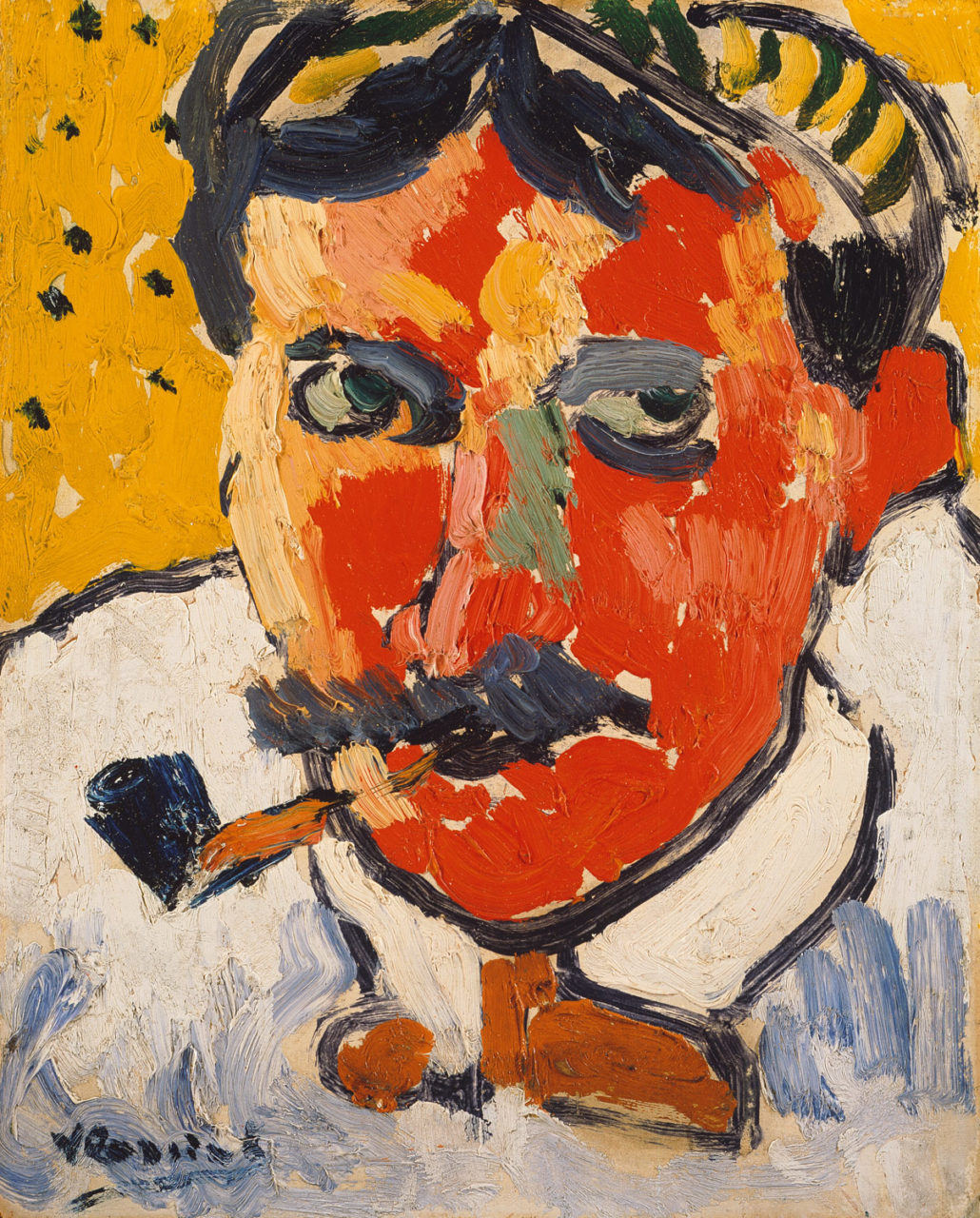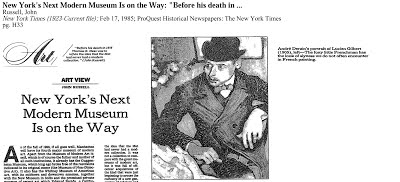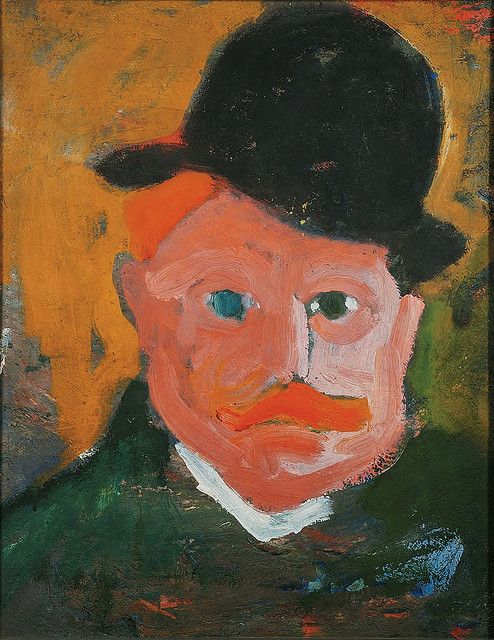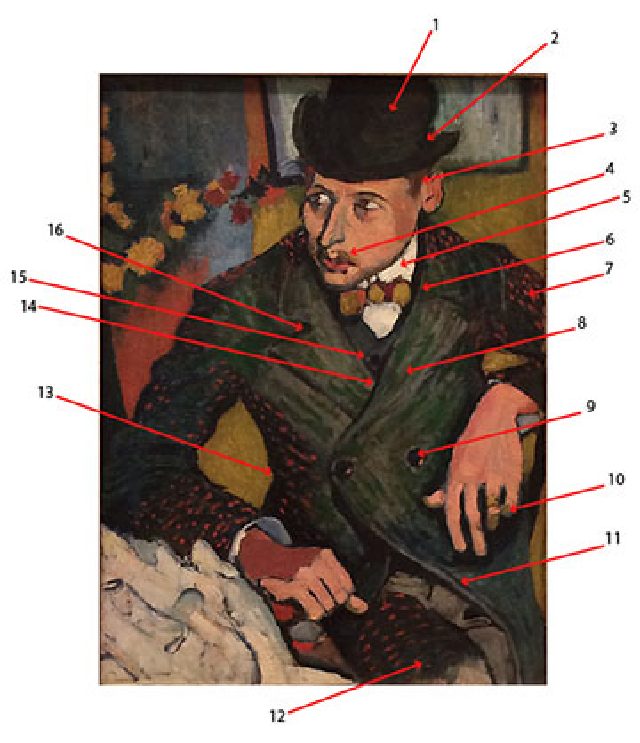André Derain painted his old friend Lucien Gilbert in the wild, eccentric colors and style of Fauvism. The colors may be unconventional; the sitter is not. Derain presents Gilbert, a future architect, as a proper young professional: stylish but conservative.
About the Portrait
André Derain (1880-1954, Fig. 1) was born in Chatou, a small town in the Île-de-France region outside of Paris (Diehl 8; Lee, 1990, 11-13). His father, a successful pâtissier and municipal councilor, was a small bourgeois who hoped to increase his son’s success (Werner 200). Despite Derain’s early interest in an artistic career, his father pressured him to become an officer or an engineer (Sutton 6; Lee 11).
Derain was fortunate to make the acquaintance of the painter Henri Matisse (1869-1954), who was sympathetic because his own father had made him waste years pursuing a legal career before Matisse rebelled. Matisse scheduled a meeting with Derain’s father, bringing along his wife as support to argue for art as a respectable career. After a long debate, Derain’s father finally gave in (Werner 200-1; Diehl 8; Lee 19).
In 1905, Matisse and Derain spent the summer in the small Mediterranean fishing village of Collioure (Fig. 2) in southwest France (Lee). Greatly inspired by the strong light and atmosphere, they painted each other’s portraits (Figs. 3 and 4; Matisse’s rendition of Derain can be compared to a 1903 photograph in Fig. 5) as well as many other works. This proved to be a turning point in Derain’s career. After the summer was over, Matisse encouraged him to show works at the Salon d’Automne [Autumn Salon]. Gallery VII was filled with wild paintings in which color was used like “sticks of dynamite,” Derain later recalled (Brenner 4). To skeptics, the pictures had nothing to do with painting: they were a “formless confusion of colors . . . splotches of pigments crudely juxtaposed.” (Werner 202) Upon seeing them, critic Louis Vauxcelles pronounced the paintings “fauves” – wild beasts (Lee 21). This name was quickly applied to the artists themselves. Fauvism, the first art movement of the twentieth century, was born.
The same year, a dealer bought all of Derain’s works and commissioned him to paint scenes of London (Sutton 14). Derain produced twenty-nine known works, each remarkable for their vivid colors and composition (Fig. 5). Even at the height of his involvement, he was considered the “tamest” of the Fauves, especially in comparison with his friend Maurice de Vlaminck (see Fig. 1) (Werner 202).
Fig. 1 - Maurice de Vlaminck (French, 1880-1954). André Derain, 1906. Oil on cardboard; 27 × 22.2 cm (10 5/8 × 12 3/4 in). New York: Metropolitan Museum of Art, 1999.363.83. Source: MMA
Fig. 2 - André Derain (French, 1880-1954). Fishing Boats, Collioure, 1906. Oil on canvas; 81 x 100.3 cm (31 7/8 x 39 1/2 in). New York: Metropolitan Museum of Art,, 1999.363.83. Source: MMA
Fig. 3 - André Derain (French, 1880-1954). Henri Matisse, 1905. Oil on canvas; 460 x 349 cm (18.1 x 13.7 in). London: Tate, T00165. Source: Tate
Fig. 4 - Henri Matisse (French, 1869-1954). André Derain, 1905. Oil on canvas; 394 x 289 cm (15.5 x 11.3 in). London: Tate, N06241. Source: Tate
Fig. 5 - Photographer unknown. André Derain, 1903. Photograph. Source: Musée Fournaise
THE SITTER
Not much is known about Lucien Gilbert (1881-1947). He had been friends with Derain since childhood and “one must not forget that he is also a remarkable painter,” the Revue du vrai et du beau reminded readers in 1923 (Balleroy). While Gilbert was producing fine work like the painting in figure 6 while in his teens, Gilbert’s father, like Derain’s, strongly encouraged him to pursue an alternate profession. He eventually became an architect and took over his father’s business rather than remain a painter.
In his collected letters, Derain discusses spending time with Gilbert, painting and drinking (Dagen, 90, n.6). Gilbert was Derain’s very first collector and over the course of his life he acquired fourteen of Derain’s paintings. They were close, and in another letter Derain once wondered if he was projecting his own unhappiness onto him: “Gilbert seemed lost to me. Or is it me?” (Dagen, 143).
This portrait may have been painting during one of their outings. There is an ink study for this picture in a sketchbook used by Derain between 1904–6 (Fig. 7), and a second portrait of Gilbert is said to have been owned by Alice Derain, the painter’s wife (MAM, 130).
This striking painting of a young man with a heart-shaped face has only occasionally provoked reactions over the years and is not routinely included with other 1905 works of his in books and catalogues. The Metropolitan Museum of Art acquired the painting in 1975, and when writing about the portrait in 1985 (Fig. 8), New York Times critic John Russell saw “a refusal to stick with the classic canons of portraiture.” He was charmed by the informality of the work and Gilbert’s headgear:
“[T]he foxy little Frenchman in the Derain has precisely the look of slyness and connivance that we know so well from French life but do not often encounter in French painting. The very tilt of his derby contributes to this.” (Russell)
Another critic saw not Gallic guile but eyes that “are uncannily alive, with an almost photographic vraisemblance that is increased rather than lessened by the overt physicality of paint and vibrancy of color” (James 338).
Fig. 6 - Lucien Gilbert (French, 1881-1947). Bords de Seine à Chatou, 1894. Oil on canvas. Chatou: Musée Fournaise. Gift of the Friends of the Maison Fournaise, 2000. Source: Musée Fournaise
Fig. 7 - André Derain (French, 1880-1954). Portrait de Lucien Gibert, 1904-6. China ink on paper; 29.7 x 19.4 cm. Paris: Centre Pompidou, AM 3671 D (147). Source: Centre Pompidou
Fig. 8 - John Russell (American). NEW YORK'S NEXT MODERN MUSEUM IS ON THE WAY, Feb. 17, 1985. New York Times. Source: NYT Archive
André Derain (French, 1880–1954). Lucien Gilbert, ca. 1905. Oil on canvas; 81.3 x 60.3 cm (32 x 23 3/4 in). New York: Metropolitan Museum of Art, 1975.169. Gift of Joyce Blaffer von Bothmer, in memory of Mr. and Mrs. Robert Lee Blaffer, 1975. Source: The Met

About the Fashion
Any analysis of Gilbert’s clothing presents some challenges. The first and most obvious is that the painting uses Fauvist, proto-Expressionist techniques. Here, Derain’s artistic style trumps faithful representation of the clothing.
The clothing is in the English style but worn by a Frenchman. Although England was the center for menswear and cemented its hegemony with the creation of the Savile Row tradition, local tailors in France and America interpreted styles as was appropriate to their clientele. As there is no information about Gilbert visiting London in the early 1900s and his clothing appears to be custom-tailored, perhaps he ordered his clothes from a French tailor who followed English styles and presented fashion plates to clients.
Derain also inconveniently truncates our view of Gilbert, cutting off the top of his hat and slicing off his lower torso. We can, at best, only make educated guesses about the full silhouette.
In 1905, King Edward VII had been on the throne for four years (we now call his reign in England the ‘Edwardian’ era). A style-setter with the largest wardrobe in the world (Marly 109), he was a model for men who aspired to be well-dressed (Figs. 9 & 10). In France and England, royalty and the aristocracy still exerted considerable influence on styles (Marly 109, 110). The ideal of the well-dressed man in this decade was to look genteel, prosperous and athletic (Schoeffler 4).
It is hard to say with certainty the kind of coat that Gilbert is wearing; it is unclear how faithful Derain was in depicting the garment and Gilbert’s sitting position obscures the actual cut. It appears to be fit closely to the waist, has a notched collar, and the front is double-breasted with two parallel buttons. The fronts also appear to be cut away from the torso, but this could be an illusion due to how he is seated. (It is also possible that the coat had additional buttons that Derain has simply not painted.)
Given these details, Gilbert may be wearing either a walking coat (Fig. 11) or a kind of cut-away frock or sack coat (Fig. 12). Walking coats were less formal versions of morning coats, though both were usually single-breasted and cut without a waist seam. Vogue advised men to purchase a morning coat to “vary the monotony of the sack [coat] for business and street dress” (Nov 2, 1905, 526). Such a coat featured a waist seam and was worn with a trim-cut trouser (Schoeffler 3). The coat extended to the knees and had a sharply cutaway front; unlike the sack coat, walking and morning coats had subtle shaping (Schoeffler 5). They was particularly popular among businessmen and professionals, especially those of heavy build and was considered appropriate for afternoon functions if made of dark-toned fabrics (Schoeffler, 4-5). One-button coats (Fig. 13) were similarly designed for stouter or “stomached” men and sometimes called the “fat man’s frock” or “fat man’s sack” (Baker, 96-97), but double-breasted one-button coats were a relatively rare fashion at this time. Gilbert appears slim, so it is possible there were simply more buttons that Derain neglected to paint.
Gilbert’s suit is probably not a lounge suit (called a “sack suit” in the United States), as they were usually loose-fitting and concealed the shape of the body. Beaux-Arts sculptor Paul Bartlett (Fig. 14) is wearing a sack suit with only the top button done up, a common affectation around the turn of the century and possibly also what Gilbert is doing in his own portrait.
The gorge (variously defined as the neck seam or front neckline of a coat or waistcoat in menswear) of the coat is low compared to that of coats worn only a few years before, such as the one Derain himself is wearing in his 1903 photograph (Fig. 5). The lapels have grown somewhat wider, the notches deeper, compared to those on styles in the past (Fig. 14). Around 1905, the neckline opening dropped slightly and lapels widened (Hill 2022, 560). The front of the coat worn by Bartolomeo Savona, a Sicilian student whom Derain painted in 1906, has a similar cut (Fig. 15).
By this time, the frock coat was on the wane in Europe and had gone from being ordinary visiting dress to more archaic, highly formal dress (Chenoune 122; Constantino, 9). In A History of Men’s Fashion (1993), Farid Chenoune describes:
“In France in 1901, President Paul Deschanel, known as a stylish dresser, created a scandal by getting married in a frock coat rather than the traditional dress coat. This simply confirmed the frock coat’s slide into a purely formal role. For the younger generation, this strange garment that ‘fell to the knees’ was appropriate only for special occasions and seemed increasingly silly as daytime wear.” (Chenoune 122)
If Gilbert is wearing a variety of frock coat, he is slightly out of step with the current fashion for young men of his time. Perhaps this style was still comme il faut on the sleepier streets of Chatou than on a sophisticated Paris boulevard…
Detail or Divisionism?
The fabric of his coat is represented as a bright green with red flecks. This is usually interpreted as an expression of Divisionism, a color and optics theory popular among some painters at the time (Dorra 51-52; MAM, 130). In support, they point to another Derain painting completed around the same time, Self-Portrait with a Cap (Fig. 16), which sports the same effect.
The other possibility is that Derain was painting a literal or expressionistic version of green tweed, a fabric on offer for suits which was popular in Britain and its colonies in this period (Fig. 17) (Anderson). In Men’s Fashion Illustrations from the Turn of the Century (1990), Jean Druesedow quotes The Sartorial Art Journal from 1908:
“A very important difference between custom-made and ready-to-wear clothes is that the former may be expressive of the wearer’s mind, not only in an art direction, but as regards sartorial utility and appropriateness, whereas the latter express only the ideas and views of the designer plus, perhaps, those of his employer and associates.” (vii)
Ready-to-wear suits had been on the market since the late 19th century but tended to be black (Chenoune 89). If a man had only one suit, it was usually a dark blue serge (Schoeffler 3).
Gilbert’s color choice, if it was actually a green tweed, would have been a bold one for his era: “The well-dressed man of the first decade of this century was for the most part a conservative dresser who used color judiciously. A sack suit of dark blue, dark gray, or black was a staple of his wardrobe,” O.E. Schoeffler writes in Esquire’s Encyclopedia of 20th Century Men’s Fashions (1973, 570). More likely, though, it was a subtler dark wool in green, navy, or black, and Derain spiced it up in his portrait.
Off-the-rack clothes had another important drawback: Poor fit. A poorly-cut lounge suit is forgiving; a coat that fits closely to the chest and waist is not. A garment that fits closely with shaping through a waist seam has to be made for the individual or tailored after the fact. As Gilbert was the son of an architect and deputy mayor, he may have been able to afford custom-tailored clothes.
Trousers, vest, shirt, neckwear
The trousers are of the same fabric as the coat and have no visible crease, a departure from the predominant fashion (Fig. 18) (Chenoune 118-19). We cannot see if the trousers have cuffs, also called “turn-ups” or “roll-ups,” which had become popular in years prior, although they were not without controversy (Chenoune 117).
Vests, or waistcoats, were almost always worn with a suit (Schoeffler, 229; Hill 2022, 562). Gilbert’s vest looks black, but might be the same color as the coat; Derain’s flourishes make it hard to tell. Vests were available in a variety of shapes (Fig. 19), but Gilbert’s is cut so that only one button is visible above the gorge of the coat, a style preference that remains popular today.
The shirt is a “coat front,” which had been popular for about fifteen years instead of a pullover style (Hill 2022, 520, 563). Unlike shirts with detachable collars, which were favored by this time by men of limited means to cut down on laundry, Gilbert’s white collar appears to be part of the shirt.
“[C]ollars became a form of identity expressing, on the one hand, a man’s socioeconomic status, and on the other, his personality and lifestyle. A gaping, V-front collar might represent an artist or writer of some success, whereas the rigidly starched neck-brace styles were the mark of a bourgeois gentleman or businessman.” (Hill 520)
It would make sense if Gilbert, the would-be architect and bourgeois by birth, was wearing a collared shirt. What we can see is his bright bow-tie in a color that meanders between mustard yellow and deep red. Many choices of color and texture were available for men’s neckwear at this time, and loud colors were more popular with the younger sort (Hill 2014, 75). In figure 15, Savona’s tie is striped in muted colors. No man was considered properly dressed without neckwear of some kind at this time – but he also needed a hat.
Hat and Jewelry
Like any respectable man of his day, Gilbert wears a hat, what some consider to have been “the most important accessory for the Edwardian man” (Hill 2022, 567). By 1905, the top hat experienced its peak as a form of headgear (Chenoune 127). Gilbert sports a bowler (called a “derby” in the U.S.), which was a hat with a “low, round, bowl-shaped crown and short circular brim [that] is usually slightly curled” (Gavenas 54). His hatband, around the base of the crown, nearly blends in to the hat underneath. Such hats were fashionable outdoors and informal attire (Fig. 18), and Derain also painted his friend Maurice Vlaminck in one in 1905 (Fig. 20).
Gilbert wears only a single ring, possibly a wedding band. Victorian gentlemen were advised to wear minimal jewelry (Hill 2022, 524). In the Edwardian era, some ostentation was permitted, including cuff links and a stick pin (Schoeffler 322). We cannot see much of his vest, but ordinarily a watch and fob were worn, often hooked through the vest (Fig. 21) (Schoeffler 326). Wrist watches only appeared around World War I.
Grooming
To accommodate his hat, Gilbert’s hair is clipped short. His face is clean-shaven except for a wispy mustache. This is consistent with the French preference of the period (Fig. 20; see the Irish, Fig. 21). Beards had been popular again starting around 1850, but around 1901 the clean-shaven look gained vogue, especially for younger men (Schoeffler 478; Hill 570) and in America (Fig. 18).
Some allowance was made for mustaches, which were considered more fashionable than beards and had a ‘soldierly’ air, but a face free of hair was considered to be more hygienic option (Schoeffler 478). In America, the invention of the disposable safety razor in 1903 also played a role in this fashion (Hill 2022, 570).
Overall, Gilbert’s ensemble shows that he is a young professional with an eye for style and the money to have clothing fitted properly to his frame. Based on the portraits of him and others in the circle–Derain and Vlaminck–we see a group of young artists dressing in the same style and grooming themselves similarly, creating a cohesive image for their professions.
Fig. 9 - Lafayette (British, fl.1880-1952). King Edward VII (1841-1910) wearing an Inverness cape, ca. 1905. Gelatin silver photographic print; 37.9 x 22 cm. London: Royal Collection Trust, RCIN 2107424. Source: RCT
Fig. 10 - Photographer unknown. Portrait photograph of King Edward VII (1841-1910), when Albert Edward, Prince of Wales, November 1871. Albumen photographic print pasted onto card; 12.9 x 9.1 cm. London: Royal Collection Trust, RCIN 2107090. Source: RCT
Fig. 11 - Vogue (British). Fashion: The Well-Dressed Man (walking coat and waistcoat), March 16, 1905. Source: ProQuest
Fig. 12 - Vogue (British). Double-breasted sack coat, March 30, 1905. Source: ProQuest
Fig. 13 - The Delineator (American). Men's or Boy's Sack Coat, March 1905. Source: Google Books
Fig. 14 - Charles Sprague Pearce (American, active France, 1851-1914). Paul Wayland Bartlett, ca. 1890. Oil on canvas; 150.5 x 117.8 x 12.1 cm (59 1/4 x 46 3/8 x 4 3/4 in). Washington, DC: National Portrait Gallery, NPG.65.20. National Portrait Gallery, Smithsonian Institution; transfer from the Smithsonian American Art Museum; gift of Caroline Peter (Mrs. Armistead Peter III), 1958. Source: NPG
Fig. 15 - André Derain (French, 1880-1954). Bartolomeo Savona, 1906. Oil on canvas; 45.7 x 35.4 cm (18 x 13.9 in). Birmingham, England: The Barber Institute of Fine Arts, 97.1. Purchased with financial assistance from the Heritage Lottery Fund and the National Art Collections Fund, 1997. Source: Barber Institute of Fine Arts
Fig. 16 - André Derain (French, 1880-1954). Self-Portrait with A Cap, 1905. Oil on canvas; 25.5 x 33 cm (10 x 12.9 in). Private collection. Source: WikiArt
Fig. 17 - Ichizo Sato (Japanese, active Australia). Tweed suit worn by Hasegawa Setsutaro, ca. 1910. Wool. Australia: Museums Victoria, 1556705. Donation from Andrew Hasegawa, 08 Oct 2009. Source: Museums Victoria
Fig. 18 - The John J. Mitchell Co. (American). American Fashions, September 1904. Fashion plate. New York: Metropolitan Museum of Art, b1752524x. Source: Watsononline
Fig. 19 - B. Stern & Son (American). Waistcoat fashions, 1906. Fashion plate. New York: Metropolitan Museum of Art, b1752524x. Source: Watsononline
Fig. 20 - André Derain (French, 1880-1954). Portrait of Vlaminck, 1905. Oil on canvas. Source: Omeka
Fig. 21 - Photographer unknown (Irish). Studio portrait of Mr Foley of Ferrybank, Waterford, February 1905. Photograph. Dublin: National Library of Ireland, P_WP_1442. Source: Flickr
References:
- Baker, William Henry. A Dictionary of Men’s Wear. Cleveland: The Britton Printing Co., 1908. Google Books.
- Balleroy, C. “Les Salons.” Revue du vrai et du beau : Lettres et Arts, January 10, 1923, 9. http://gallica.bnf.fr/ark:/12148/bpt6k6361704z/f12.item.r.
- Brenner, Carla, “Henri Matisse: Color and Light.” Teacher’s Guide: School Arts: Looking/Learning, 1999. http://archive.org/details/ERIC_ED450026.
- Chenoune, Farid. A History of Men’s Fashion. Paris: Flammarion, 1993. Worldcat.
- Costantino, Maria. Men’s Fashion in the Twentieth Century: From Frock Coats to Intelligent Fibres. London: B.T. Batsford, 1997. Worldcat.
- Dagen, Philippe. Lettres À Vlaminck: Suivies De La Correspondance De Guerre. Paris: Flammarion, 1994. Worldcat.
- Diehl, Gaston. Derain. New York: Crown Publishers, 1964. Worldcat.
- Dorra, Henri. “The Wild Beasts — Fauvism and Its Affinities at the Museum of Modern Art.” Art Journal 36, no. 1 (1976): 50-54. http://www.jstor.org/stable/776115.
- Druesedow, Jean L. Men’s Fashion Illustrations from the Turn of the Century. New York: Dover, 1990. Worldcat.
- “Fashion: The well-dressed man.” Vogue 26 (Nov. 30, 1905), 714. http://libproxy.fitsuny.edu:2074/docview/904260583?accountid=27253
- Gavenas, Mary Lisa. The Fairchild Encyclopedia of Menswear. New York: Fairchild Publications, 2008. Worldcat.
- Hill, Daniel Delis. History of World Costume and Fashion. Upper Saddle River, NJ: Pearson Prentice Hall, 2022. Worldcat.
- Hill, Daniel Delis. Necessaries: Two Hundred Years of Fashion Accessories. San Antonio, TX: Gemini Dragon, 2014. Google Books.
- James, Merlin. “André Derain. Madrid and Paris.” The Burlington Magazine 137: 1106 (1995), 338–41. http://www.jstor.org/stable/886642.
- Lee, Jane. Derain. Oxford: Phaidon, 1990. Worldcat.
- Lee, Jane. “Derain, André.” Grove Art Online. Oxford Art Online. Oxford University Press. Accessed May 5, 2016. http://www.oxfordartonline.com/subscriber/article/grove/art/T022279
- MAM (Musée d’art moderne). André Derain: Le Peintre Du “Trouble Moderne”: Musée D’art Moderne De La Ville De Paris, 18 Novembre 1994-19 Mars 1995. Paris: Paris Musées, 1994. Worldcat.
- Marly, Diana de. Fashion for Men: An Illustrated History. New York: Holmes & Meier, 1985. Worldcat.
- Russell, John. “Art View; New York’s Next Modern Museum Is on the Way.” The New York Times, February 17, 1985. http://www.nytimes.com/1985/02/17/arts/art-view-new-york-s-next-modern-museum-is-on-the-way.html
- Schoeffler, O. E., and William Gale. Esquire’s Encyclopedia of 20th Century Men’s Fashions. New York: McGraw-Hill, 1973. Worldcat.
- Sutton, Denys. André Derain. London: Phaidon Press, 1959. Worldcat.
- Werner, Alfred. “The Fauve Who Was No Beast.” The Antioch Review 16, no. 2 (1956): 198. doi:10.2307/4609867. http://www.jstor.org/stable/4609867
































